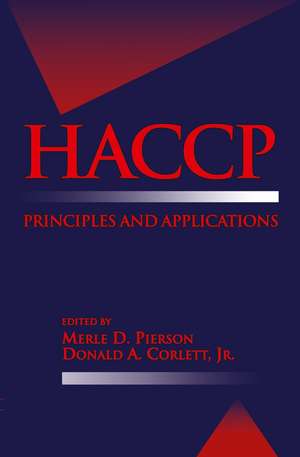HACCP: Principles and Applications
Autor Merle D. Piersonen Limba Engleză Paperback – 8 oct 2012
Preț: 384.31 lei
Nou
Puncte Express: 576
Preț estimativ în valută:
73.55€ • 76.50$ • 60.72£
73.55€ • 76.50$ • 60.72£
Carte tipărită la comandă
Livrare economică 14-28 aprilie
Preluare comenzi: 021 569.72.76
Specificații
ISBN-13: 9781468488203
ISBN-10: 1468488201
Pagini: 228
Ilustrații: XI, 212 p.
Dimensiuni: 155 x 235 x 12 mm
Greutate: 0.33 kg
Ediția:1992
Editura: Springer Us
Colecția Springer
Locul publicării:New York, NY, United States
ISBN-10: 1468488201
Pagini: 228
Ilustrații: XI, 212 p.
Dimensiuni: 155 x 235 x 12 mm
Greutate: 0.33 kg
Ediția:1992
Editura: Springer Us
Colecția Springer
Locul publicării:New York, NY, United States
Public țintă
ResearchCuprins
1 Introduction to HACCP.- References.- 2 HACCP: Definitions and Principles.- References.- 3 Overview of Biological, Chemical, and Physical Hazards.- Biological Hazards.- Chemical Hazards.- Physical Hazards.- References.- 4 Hazard Analysis and Assignment of Risk Categories.- Overview.- Microbiological Hazard Characteristic Ranking.- Chemical and Physical Hazard Risk Assessment Procedures.- Examples of the Combined Hazard Analysis for Cheese Dip.- References.- 5 Determining Critical Control Points.- Representative CCPs.- Low-acid Canned Foods CCPs.- Summary.- 6 Establishing Critical Limits for Critical Control Points.- Limits: Definitions & Guidelines.- Establishing Limits for Critical Control Points.- Conclusion.- References.- 7 Monitoring Critical Control Point Critical Limits.- What is Monitoring?.- Why Do We Monitor?.- How Do We Monitor?.- Where Do We Monitor?.- Who Monitors?.- When Do We Monitor?.- Summary.- References.- 8 Corrective Action Procedures for Deviations from the Critical Control Point Critical Limits.- Corrective Action Activities.- References.- 9 Effective Recordkeeping System for Documenting the HACCP Plan.- Types of HACCP Records.- Record Review and Retention.- The HACCP Plan.- Summary.- 10 Verification of the HACCP Program.- Importance.- Prevention.- Team Approach.- Essential Elements.- Critical Control Point Verification.- Verification vs. Monitoring.- HACCP Program Verification.- Finished Product Testing.- Records.- Written Report.- 11 Control Points and Critical Control Points.- Definitions.- Comprehensive Product Control System.- Summary.- References.- 12 Putting the Pieces Together: Developing an Action Plan for Implementing HACCP.- Where Does HACCP Fit into a Company?.- Establishing HACCP Accountabilities.- Establishing the HACCP ImplementationProject Plan.- Establishing Policy.- Appointment of the Core HACCP Coordinator and Team.- Development of the Product Specific HACCP Plan.- Developing Production Supervisor or Individual Operator Procedures.- Getting the Job Completed.- References.- 13 HACCP System in Regulatory Inspection Programs: Case Studies of the USDA, USDC, and DOD.- USDA-FSIS HACCP Project.- NMFS HACCP Project.- Joint FDA/NOAA Seafood Inspection Program.- HACCP Applications in Food Procurement and Handling for DOD.- Conclusions.- References.- 14 Practical Application of HACCP.- Product Description.- Risk Assessment.- Process Flow Charts.- Critical Control Points and Limits.- Models.- Application of HACCP to Foodservice.- Summary.- References.- A HACCP Principles for Food Production.- C National Advisory Committee on Microbiological Criteria for Foods, Hazard Analysis and Critical Control Point System Adopted March 20, 1992.
